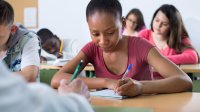The Role of Cognition in the Gradual Release of Responsibility Model
Teachers can support students’ success by providing ample time for them to process and gain independence in completing complex tasks.
Your content has been saved!
Go to My Saved Content.The gradual release of responsibility model is a familiar concept. This traditional approach to teaching is centered around the idea that a teacher will model a skill or strategy for a few minutes, briefly allow students to practice with some support, and then release the students to begin practicing on their own.
However, when we consider complex tasks, like learning a dance for a recital, for example, this model doesn’t provide a sufficient amount of time for mastery. And learning complex academic tasks is no different.
Ultimately, the goal of learning is that the student can transfer and apply their learning in different settings independently. As we begin to look more closely at our teaching practices, it’s time to ask ourselves if we’re providing enough time for students to practice skills and strategies they’re learning in order for them to gain independence and control over the task for the long term. It’s most important for teachers to understand the foundations of this work when they’re planning instruction.
Understanding the 5 Stages of the Gradual Release Model
In their book Shaping Literate Minds: Developing Self-Regulated Learners, Linda Dorn and Carla Soffos unpack Douglas Fisher and Nancy Frey’s work on the gradual release model, which originated from David Pearson and Margaret Gallagher’s research in 1983. The book outlines how to achieve student success by focusing on the change over time that happens within the student when learning occurs.
1. No awareness: In this phase of learning, the teacher introduces a focused skill or strategy to the students and models using relevant and engaging resources. The teacher models metacognition through thinking out loud so that students can see an example of how to think about this new information.
When students are made aware of new information, it enters their immediate memory inside the brain. Your immediate memory decides within about 30 seconds if there’s a connection to this new information, and if not, it will automatically begin filtering it out.
As educational neuroscientist David Sousa indicates in his book How the Brain Learns, it’s important to build a bridge from prior knowledge to new knowledge in order for students to engage in this new task and take it to working memory.
2. Becoming aware: After the students enter awareness, the teacher continues to carry most of the work with the new concept but begins to invite the students to interact more with the learning. This may look like class discussion around the theme of a text, sharing the pen in writing, or having students help the teacher through the steps of solving a math problem. Students are beginning to be more metacognitive by discussing and reflecting on what is being taught.
Ideally, in this phase the brain is interacting with the information in working memory. Keep in mind that working memory can hold on to only a few bits of information at a time. If you begin to see kids disengage from the content, their brain has entered information overload. When you keep your content focused and provide students time to process and practice the concept, their brains will stay engaged. Too much teacher talk will cause yet another filtering-out effect.
3. Performing with more help: The students are now released to practice the new concept but are provided with built-in support. Scaffolds such as working in a small group with other students, working with a partner, or working with the teacher allow them to begin practicing and talking through the task step by step but still have a knowledgeable expert nearby to intervene if necessary. The students use metacognition to help them identify what they know and reflect on areas where they still need support or intervention.
4. Perform with less help: At this point, students have been given multiple opportunities to practice the task and are now ready to take on even more ownership with less scaffolding. For example, students who are learning how to summarize a text might read independently and fill out an organizer that summarizes the events from the story. The organizer provides some support and guidance, but the students perform the bulk of the task on their own.
The brain has now been given repeated exposures to the concept being taught and in various ways. This allows for the information in working memory to strengthen the pathways necessary to recall the concept quickly and automatically. Consider bringing students back together after their structured practice time to have a reflection or sharing of the learning, so that these pathways continue to strengthen and the content stays relevant.
5. Perform with no help: Here is the real “you do.” In this final stage of the gradual release of responsibility model, students have been given the tools and time to be able to take on new information and are ready to show and apply what they’ve learned. This can include taking an assessment, creating a presentation, teaching someone else what they have learned, or simply performing the task independently. Most important in this phase, the student has gained control over the task, and the brain is able to quickly retrieve the information to carry it out.
It’s important to keep in mind that as students work through the phases to increase their control, the phases don’t have to go in only one direction. Teetering between the phases as students encounter roadblocks and shore up misconceptions may be necessary and is absolutely fine.
